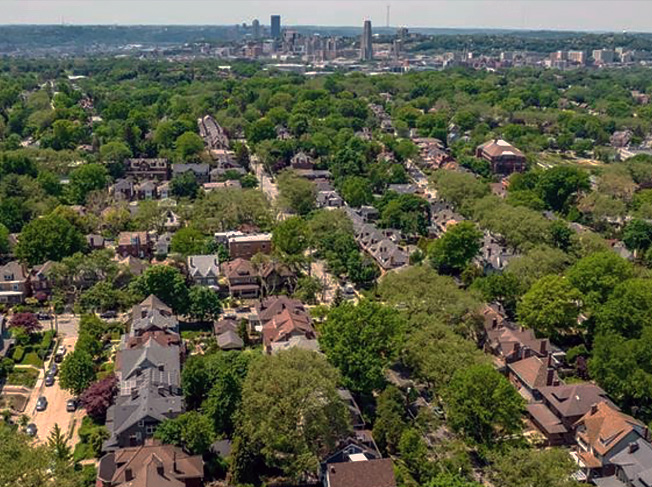Squirrel Hill was inhabited by a number of indigenous cultures prior to its incorporation into the City of Pittsburgh. These cultures include the Monongahela from the 11th to 17th centuries and the Osage. Shawnee and Lenape settlers moved into the area as white settlers pushed them out of their original lands. Economic pressure from the fur trade pushed the Iroquois to conquer the area in the 17th century, creating an additional presence.
Little development occurred in the Squirrel Hill neighborhood until well into the 19th century. It would seem that its proximity to Fort Pitt, established in 1759 would have made it the same desirable location 250 years ago that it is today. But traveling to the hilly, forested area was a hard slog by foot or by horse. That fact would prove to be beneficial as the slow development of the area would provide the community with two of the largest public parks in the country, exquisite green space bookends – to the west, Schenley Park and to the east, Frick Park.
The modern story of Squirrel Hill starts in 1760 at its southern end. The first settlement was along the Monongahela River in an area called Summerset with a house built by Colonel James Burd, a soldier at Fort Pitt. (The same general site today is a modern housing development, Summerset at Frick Park, which reclaimed a former US Steel slag dump. The elevation of the area is about 100 feet higher than when it was first settled.)
Two of the oldest residences built in Squirrel Hill still stand: the Ambrose Newton home built in the 1760s (also known as the Martin House) in Schenley Park along Overlook Drive, and the Robert Neill home built in the 1780s along East Circuit Road also in Schenley Park.
A bustling commercial district developed at the southern end near the intersections of today’s Brown’s Hill Road and Beechwood Boulevard. There is still a business district there today. But as Squirrel Hill and the rest of the city developed over the course of the 19th century, the area’s center of commerce relocated to present day Forbes Avenue and Murray Avenue to meet development in Oakland and Shadyside. The advent of a trolley line in 1893 along Forbes and down Murray and the opening of the Boulevard of the Allies in 1927 continued to spur development.
Once farmland and forest, Squirrel Hill by the 1930s had developed into an affluent city neighborhood.
Geography: Squirrel Hill North and South residential neighborhoods in the East End of the city of Pittsburgh
Population: 28,105
Total Households: 12,745
Total Business Locations: 423
Area: 2.89 square miles
School District: Pittsburgh Public Schools
Median Housing Price: $184,000
Rental Range: $500-$1500
*from the 2012-2016 U. S. American Community Survey 5-year ESTIMATE
| 14th Ward | Squirrel Hill North | Squirrel Hill South | |
| Race & Population | |||
| Population | 36,460 | 11,395 | 15,114 |
| White | 80% | 75% | 80% |
| African American | 8% | 3% | 3% |
| Asian | 8% | 17% | 11% |
| Hispanic | 2% | 4% | 3% |
| Multi-racial | 2% | 1% | 3% |
| Family Type | |||
| Number of Families | 7,045 | 1,982 | 3,216 |
| Married/couple with children | 33% | 33% | 34% |
| Married/couple, no children | 49% | 55% | 50% |
| Single with children | 8% | 5% | 6% |
| Single, no children | 10% | 7% | 10% |
| Household Income (1999) | |||
| Number of Households | 15,202 | 3,769 | 6,783 |
| more than $150,000 | 12% | 19% | 7% |
| $100,000-$149,999 | 11% | 14% | 10% |
| $75,000-$99,999 | 9% | 10% | 8% |
| $50,000-$74,999 | 16% | 14% | 16% |
| $35,000-$49,999 | 13% | 11% | 15% |
| $25,000-$34,999 | 10% | 6% | 11% |
| $15,000-$24,999 | 13% | 12% | 13% |
| $10,000-$14,999 | 6% | 4% | 7% |
| less than $10,000 | 10% | 10% | 13% |
| Education (age 25+) | |||
| Number of People | 23,396 | 5,818 | 10,522 |
| Graduate/professional degree | 39% | 49% | 37% |
| Bachelor’s degree | 25% | 26% | 27% |
| Associate’s degree | 4% | 4% | 4% |
| Some college, no degree | 12% | 11% | 10% |
| High school diploma/GED | 14% | 6% | 15% |
| 9th-12th grade, no diploma | 4% | 3% | 5% |
| Less than 9th grade | 2% | 1% | 2% |
| Age of Population | |||
| Number of People | 36,380 | 11,395 | 15,114 |
| 65+ | 16% | 12% | 20% |
| 45-64 | 22% | 18% | 21% |
| 25-44 | 27% | 20% | 31% |
| 18-24 | 18% | 37% | 11% |
| less than 18 | 17% | 13% | 17% |

Enter your email address to subscribe to our newsletter and receive notifications of new posts by email.
this is a test
this is a test